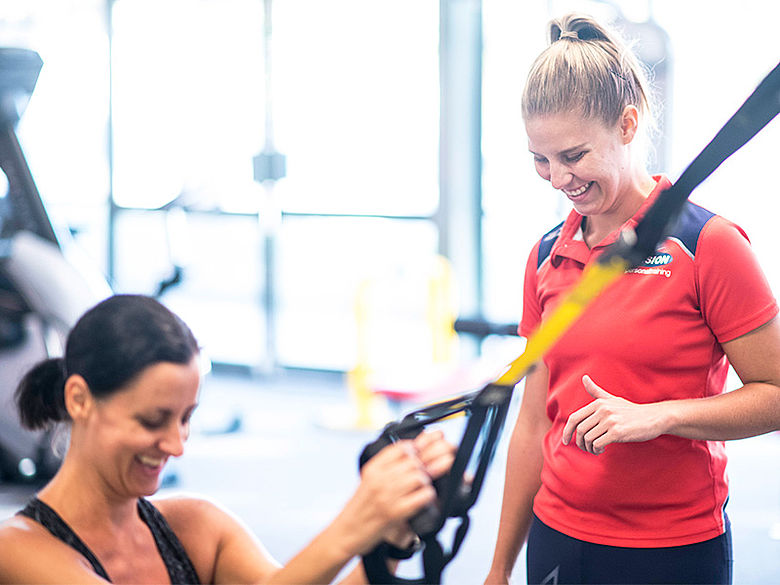What do you think of when a Trainer says to you “brace your core”? Most of us view the core as our “abs.” However, your true core consists of the following muscles:
-
Diaphragm
-
Transverse abdominus
-
Multifidus
-
Pelvic floor
During training, particularly weights training, you may hear a Trainer say to you “brace your core” or “pull your tummy in.” This cue does contribute to stabilisation of your core musculature, however, it is important to feel and activate the pelvic floor as part of this “brace core” process.
So, what exactly are the pelvic floor muscles? The pelvis is made up of layers of muscle and various tissues (imagine like a hammock) connecting your tailbone to your pubic bone at the front. For example, in women the pelvic floor muscles support the bladder, the uterus and bowel. The urethra, vagina and the rectum all pass through the pelvic floor muscles too, thus allowing control of our bladder, bowel, and sexual functions.
Being inactive or pregnant, giving birth, bowel strain from constipation or growing older, can all contribute to a weakening of the pelvic floor and associated muscles. As such, the pelvic floor requires to be strong enough to reduce or manage the direct impact of factors such as these. The pelvic floor should also be strong enough to support heavy loads while pregnant, if overweight, or while carrying and lifting heavy weights.
Strengthening the pelvic floor muscles is vital to assist in:
-
Reducing symptoms of stress incontinence (leaking bladders)
-
Reducing symptoms of pelvic floor dysfunction
-
Helping the body support a growing baby during pregnancy
-
Helping the body become labour fit (baby ready)
-
Reducing the chance of having bowel or bladder problems after giving birth
-
Lessening the effect of menopause in pelvic organ support and bladder control (i.e., prolapse)
In our studio, the majority of our clientele are women. Many of whom could be planning to become pregnant, are already pregnant or who have given birth in the past. Some may be improving their body composition, while others may be increasing their physical capacity as they move into older age and as such, should consider strengthening their pelvic floor as part of improving their overall strength and fitness.
Did you also know, when functioning effectively, the diaphragm and the pelvic floor have a symbiotic relationship? Your diaphragm, located towards the bottom of your lungs, contracts and flattens allowing air to fill your lungs when you breathe in. When this occurs, the diaphragm causes downward pressure on your pelvic floor, which in turn is also pressed downwards. As you exhale, the opposite occurs creating and regulating pressure. Both the pelvic floor and diaphragm work together to inhale and help expel the air from your lungs.
So how do you activate and use your pelvic floor muscles? Two things we are going to focus on (without too many giggles), is activating the muscles around the anus and underneath the pelvis. Let us do it right now:
-
Imagine trying to activate the muscles underneath your pelvis that allow you to stop yourself from doing a number 1 (urinating). Now, while those are switched on, activate your muscles around the anus.
-
Try squeezing the ring of muscles around the anus as if you are trying to stop yourself from passing wind or completing a number 2 (pooping).
-
Relax both. Trying to repeat and then relax again a few times. You do not have to activate them super hard, something around 40-60% is enough.
This pelvic floor activation method should form part of the previously mentioned ‘brace core’ process, for example, while training. As you inhale and activate your core muscles by “pulling your tummy in” (your deep transverse abdominus), focus on activating your pelvic floor as instructed above. At the same time, match this activation process with your regular breathing rhythm.
Weightlifting causes abdominal pressure when an individual bares a load or uses weights. If not done correctly, weightlifting may place unnecessary excessive strain on the pelvic floor if an individual is not conscious of using their core musculature to support the body under load. So, it is important that we all focus on strengthen the pelvic floor while ensuring exercises are done correctly.
This of course is not to say to stop weights training in any way. At the end of the day, weightlifting is the most effective way of building core strength and with the proper technique, safe loads and core activation, weight bearing exercise can improve overall total core strength, helping prevent various pelvis floor dysfunctions in the long term.
Ensure you always speak with your trainer about your pelvic floor. If you cannot distinctly feel or identify the squeeze of the pelvic floor muscles noted earlier in our activation exercise, it is recommended to consult with your trainer. If you are uncomfortable with that discussion, your GP or a women’s health physiotherapist is thoroughly recommended.

